NCERT Solutions for Class 10 Maths Chapter 7 Coordinate Geometry Exercise 7
NCERT Solutions For Class 10 Maths Chapter 7 Coordinate Geometry Exercise 7 are prepared by specialised experienced mathematic teacher. Maths are most important subject of board and with the help of this chapter-wise NCERT solution and little practices you can get very good marks in your respective board exam. It also help to build a foundation for topics that will be covered in the upcoming 11th and 12th. Student can also check the Important Question with solution for class 9 to class 12.
Also Check – Best laptop under 30000 for student
Class 10 Maths Chapter 7 Coordinate Geometry Exercise 7 chapter contain total 4 exercise that has 33 questions and it covered the topic finding polynomials, Properties zeros and coefficient, area of the triangle formed by three given points. , long division of polynomials, find coordinates of the point which divides a line segment, finding a quadratic polynomial. Check Previous chapter – NCERT Solutions for Class 10 Maths Chapter 6 Triangles Exercise 6.
Important formula
Distance Formula
The distance between any two points
P(x1, y1) and Q(x2, y2) in the plane is given by,
![]()
Also the distance of the point P(x1, y1) from the origin is
![]()
Section Formula

The coordinates of the point P(x, y) which divides the line segment joining the points A(x1, y1) and B(x2, y2) internally in the ratio m1 : m2 i.e., 𝑃𝐴𝑃𝐵=𝑚1𝑚2

The coordinates of the point P(x, y) which divides the line segment joining the points A(x1, y1) and B(x2, y2) externally in the ratio, m1 : m2 i.e., 𝑃𝐴𝑃𝐵=𝑚1𝑚2 are

(iii) If the ratio in which P divides AB is K : 1, then the coordinates of the point P will be

Mid-Point Formula
The coordinates of the mid point P of the line segment joining the points A(x1, y1) and B(x2, y2) is

Area of a Triangle
The area of ∆ABC formed by the vertices A(x1, y1), B(x2, y2) is given by
![]()
Note:
(i) Area of triangle = 12 × base × Altitude
(ii) Area of polygon can be calculated by dividing it into the triangular region.
(iii) If three points are collinear then area of the triangle formed by them is zero.
Exercise 7.1
Question 1.
Find the distance between the following pairs of points:
(i) (2, 3), (4, 1)
(ii) (-5, 7), (-1, 3)
(iii) (a, b), (-a, -b)
Solution:
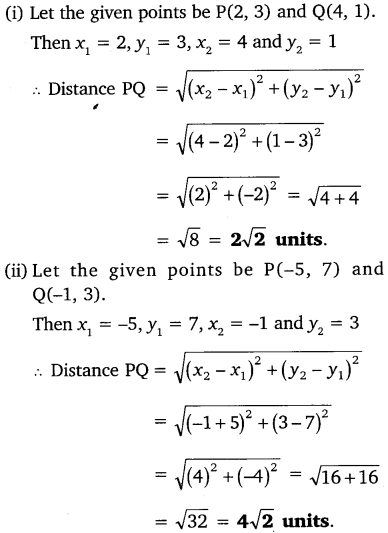
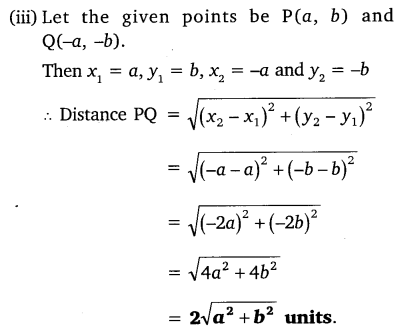
Question 2.
Find the distance between the points (0, 0) and (36, 15).
Solution:

Question 3.
Determine if the points (1, 5), (2, 3) and (-2, -11) are collinear.
Solution:
Solution: The sum of the lengths of any two line segments is equal to the length of the third line segment then all three points are collinear.
Consider, A = (1, 5) B = (2, 3) and C = (-2, -11)
Find the distance between points; say AB, BC and CA

Since AB + BC ≠ CA
Therefore, the points (1, 5), (2, 3), and ( – 2, – 11) are not collinear.
Question 4.
Check whether (5, -2), (6, 4) and (7, -2) are the vertices of an isosceles triangle.
Solution:
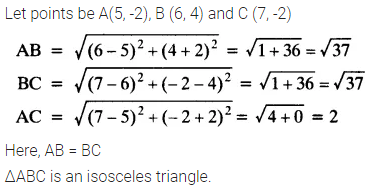
Question 5.
In a classroom, 4 friends are seated at the points A, B, C and D as shown in the given figure. Champa and Chameli walk into the class and after observing for a few minutes Champa asks Chameli, “Don’t you think ABCD is a square?” Chameli disagrees. Using distance formula, find which of them is correct.
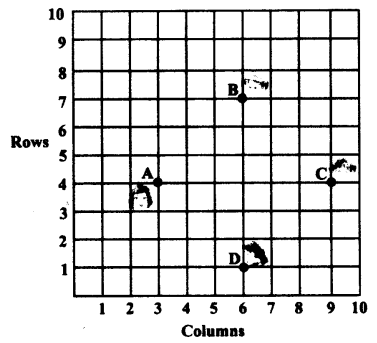
Solution:
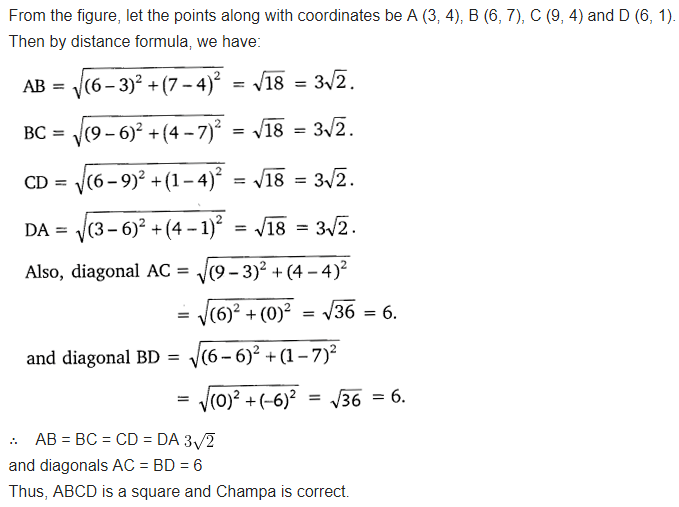
Question 6.
Name the type of quadrilateral formed, if any, by the following points, and give reasons for your answer.
(i) (-1, -2), (1, 0), (-1, 2), (-3, 0)
(ii) (-3, 5), (3, 1), (0, 3), (-1, -4)
(iii) (4, 5), (7, 6), (4, 3), (1, 2)
Solution:
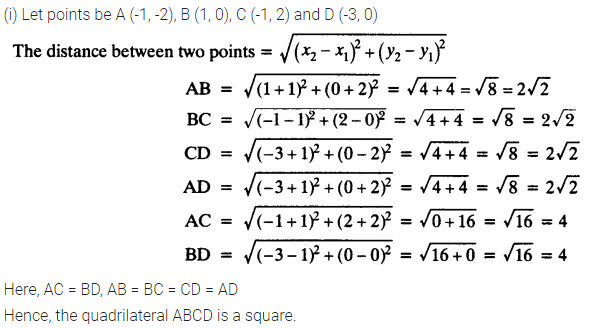
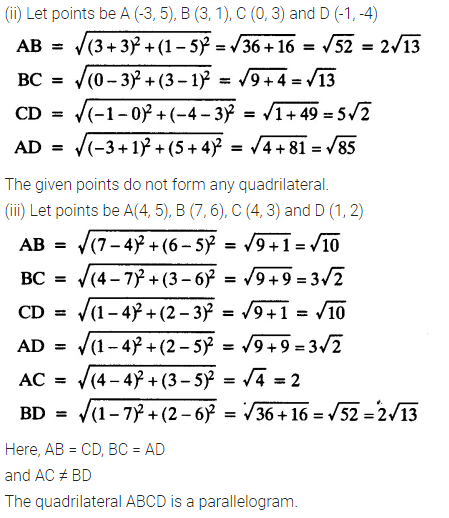
Question 7.
Find the point on the x-axis which is equidistant from (2, -5) and (-2, 9).
Solution:
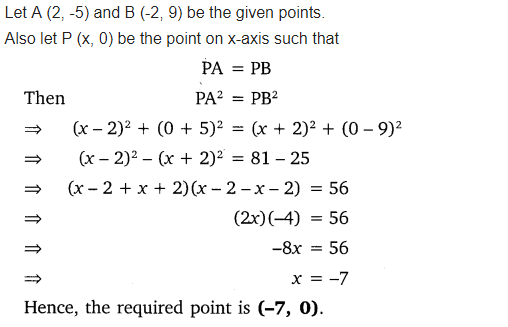
Question 8.
Find the values of y for which the distance between the points P (2, -3) and Q (10, y) is 10 units.
Solution:
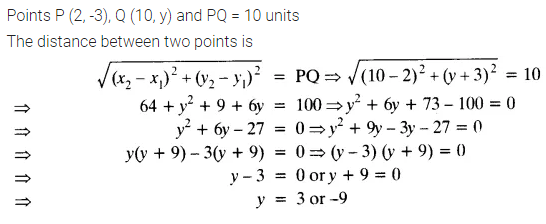
Question 9.
If Q (0, 1) is equidistant from P (5, -3), and R (x, 6), find the values of x. Also, find the distances QR and PR.
Solution:
Given: Q (0, 1) is equidistant from P (5, – 3) and R (x, 6), which means PQ = QR
Step 1: Find the distance between PQ and QR using distance formula,

Squaring both the sides, to omit square root
41 = x2 + 25
x2 = 16
x = ± 4
x = 4 or x = -4
Coordinates of Point R will be R (4, 6) or R (-4, 6),
If R (4, 6), then QR

Question 10.
Find a relation between x and y such that the point (x, y) is equidistant from the points (3, 6) and (-3, 4).
Solution:
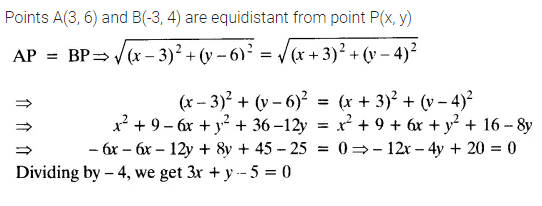
Exercise 7.2
Question 1.
Find the coordinates of the point which divides the join of (-1, 7) and (4, -3) in the ratio 2 : 3.
Solution:
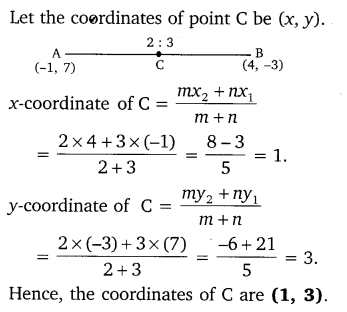
Question 2.
Find the coordinates of the points of trisection of the line segment joining (4, -1) and (-2, -3).
Solution:
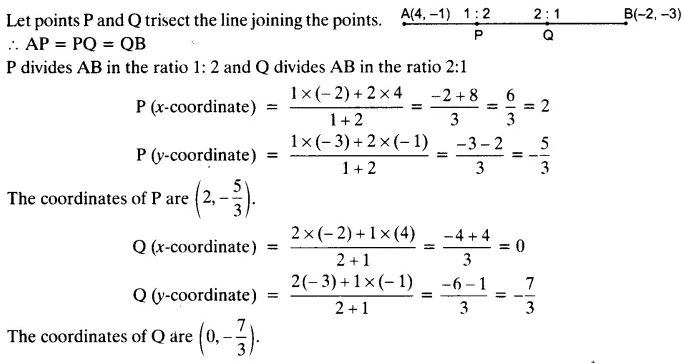
Question 3.
To conduct Sports Day activities, in your rectangular shaped school ground ABCD, lines have been drawn with chalk powder at a distance of 1 m each. 100 flower pots have been placed at a distance of 1 m from each other along AD, as shown in given
figure below. Niharika runs 14 th the distance AD on the 2nd line and posts a green flag. Preet runs 15 th distance AD on the eighth line and posts a red flag. What is the distance between both the flags? If Rashmi has to post a blue flag exactly halfway between the line segment joining the two flags, where should she post her flag?
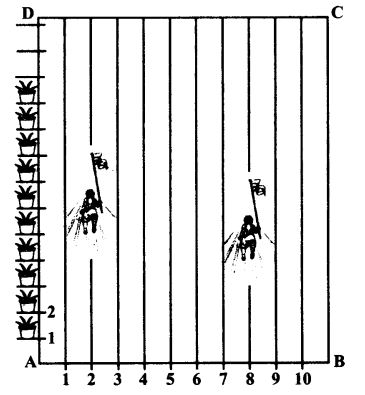
Solution:
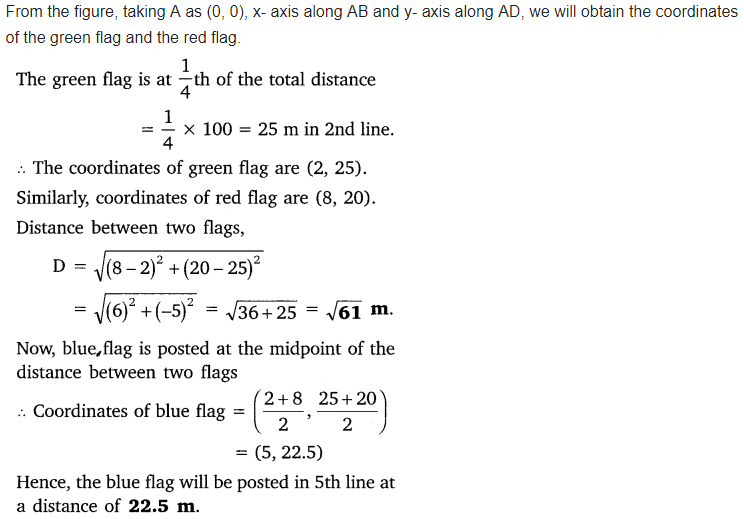
The blue flag is in the 5th line, at a distance of 22.5 m.
Question 4.
Find the ratio in which the line segment joining the points (-3, 10) and (6, -8) is divided by (-1, 6).
Solution:
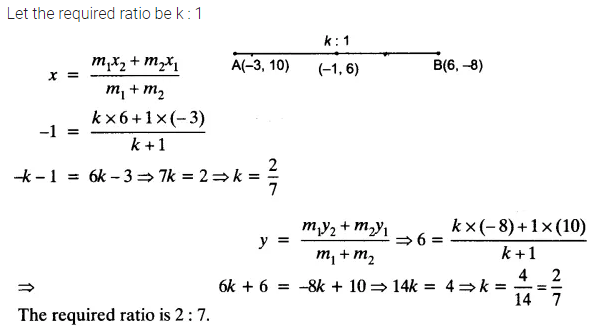
Question 5.
Find the ratio in which line segment joining A (1, -5) and B (-4, 5) is divided by the x-axis. Also, find the coordinates of the point of division.
Solution:
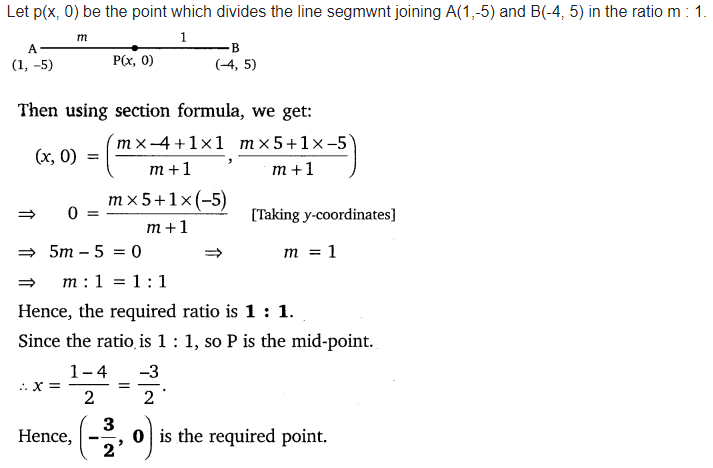
Question 6.
If (1, 2), (4, y), (x, 6) and (3, 5) are the vertices of a parallelogram taken in order, find x and y.
Solution:

Question 7.
Find the coordinates of a point A, where AB is the diameter of a circle whose centre is (2, -3) and B is (1, 4).
Solution:
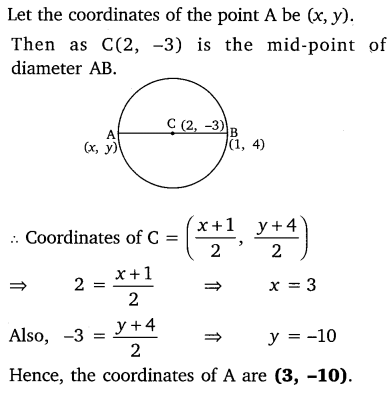
Question 8.
If A and B are (-2, -2) and (2, -4), respectively, find the coordinates of P such that AP = 37 AB and P lies on the line segment AB.
Solution:
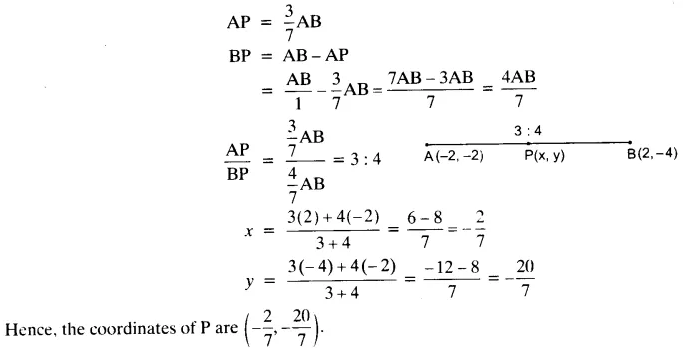
Question 9.
Find the coordinates of the points which divide the line segment joining A (-2, 2) and B (2, 8) into four equal parts.
Solution:
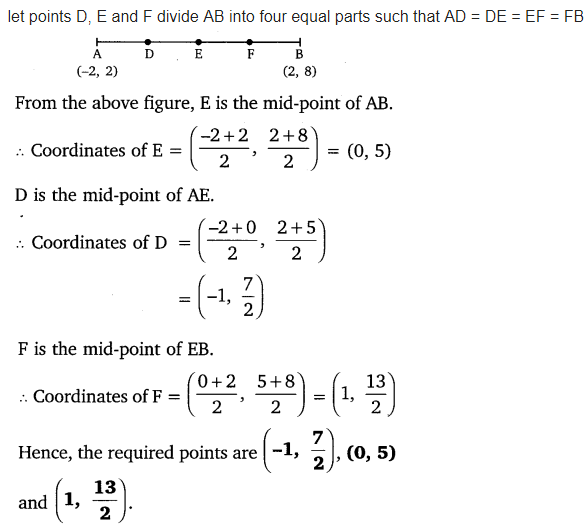
Question 10.
Find the area of a rhombus if its vertices are (3, 0), (4, 5), (-1, 4) and (-2, -1) taken in order.
[Hint: Area of a rhombus = 12 (product of its diagonals)]
Solution:
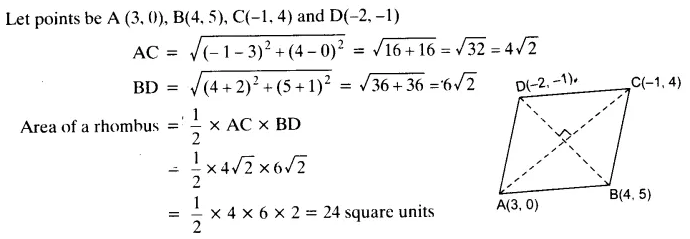
Exercise 7.3
Question 1.
Find the area of the triangle whose vertices are:
(i) (2, 3), (-1, 0), (2, -4)
(ii) (-5, -1), (3, -5), (5, 2)
Solution:
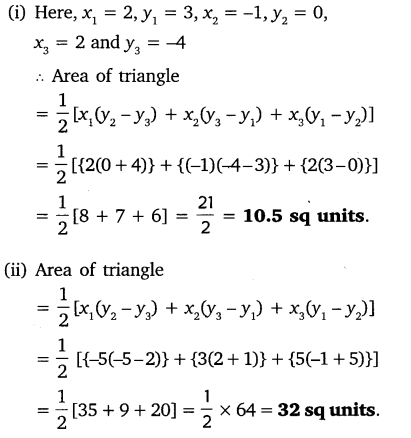
Question 2.
In each of the following find the value of ‘k’ for which the points are collinear.
(i) (7, -2), (5, 1), (3, k)
(ii) (8, 1), (k, -4), (2, -5)
Solution:
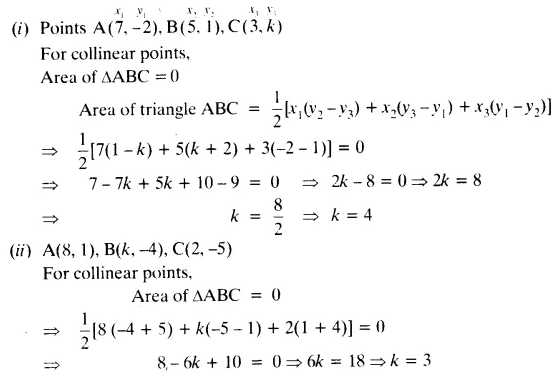
Question 3.
Find the area of the triangle formed by joining the mid-points of the sides of the triangle whose vertices are (0, -1), (2, 1) and (0, 3). Find the ratio of this area to the area of the given triangle.
Solution:
Let the vertices of the triangle be A (0, -1), B (2, 1), C (0, 3).
Let D, E, F be the mid-points of the sides of this triangle.
Coordinates of D, E, and F are given by
D = (0+2/2, -1+1/2 ) = (1, 0)
E = ( 0+0/2, -1+3/2 ) = (0, 1)
F = ( 0+2/2, 3+1/2 ) = (1, 2)

Area of a triangle = 1/2 × [x1(y2 – y3) + x2(y3 – y1) + x3(y1 – y2)]
Area of ΔDEF = 1/2 {1(2-1) + 1(1-0) + 0(0-2)} = 1/2 (1+1) = 1
Area of ΔDEF is 1 square units
Area of ΔABC = 1/2 [0(1-3) + 2{3-(-1)} + 0(-1-1)] = 1/2 {8} = 4
Area of ΔABC is 4 square units
Therefore, the required ratio is 1:4.
Question 4.
Find the area of the quadrilateral whose vertices, taken in order, are (-4, -2), (-3, -5), (3, -2) and (2, 3).
Solution:
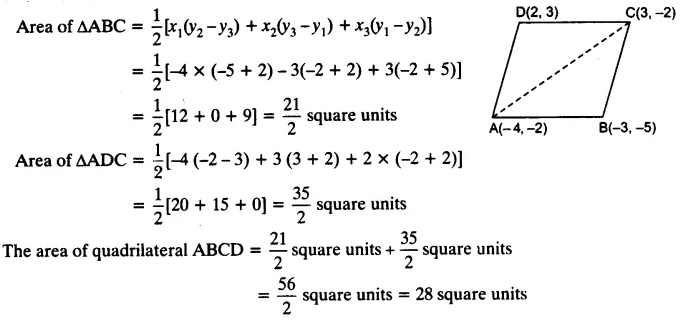
Question 5.
You have studied in Class IX, that a median of a triangle divides it into two triangles of equal areas. Verify this result for ∆ABC whose vertices are A (4, -6), B (3, -2) and C (5, 2).
Solution:
Let the vertices of the triangle be A (4, -6), B (3, -2), and C (5, 2).

Let D be the mid-point of side BC of ΔABC. Therefore, AD is the median in ΔABC.
Coordinates of point D = Midpoint of BC = ((3+5)/2, (-2+2)/2) = (4, 0)
Formula, to find Area of a triangle = 1/2 × [x1(y2 – y3) + x2(y3 – y1) + x3(y1 – y2)]
Now, Area of ΔABD = 1/2 [(4) {(-2) – (0)} + 3{(0) – (-6)} + (4) {(-6) – (-2)}]
= 1/2 (-8 + 18 – 16)
= -3 square units
However, area cannot be negative. Therefore, area of ΔABD is 3 square units.
Area of ΔACD = 1/2 [(4) {0 – (2)} + 4{(2) – (-6)} + (5) {(-6) – (0)}]
= 1/2 (-8 + 32 – 30) = -3 square units
However, area cannot be negative. Therefore, the area of ΔACD is 3 square units.
The area of both sides is the same. Thus, median AD has divided ΔABC in two triangles of equal areas.
Exercise 7.4
Question 1.
Determine the ratio, in which the line 2x + y – 4 = 0 divides the line segment joining the points A(2, -2) and B(3, 7).
Solution:
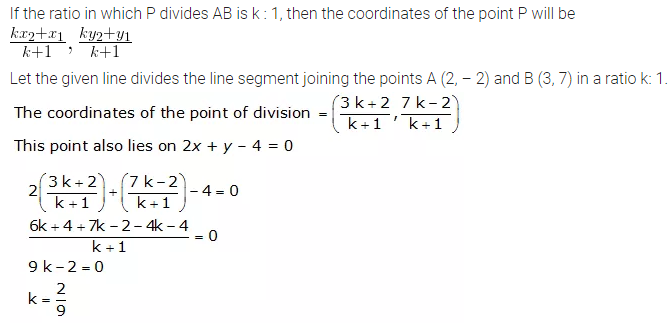
Question 2.
Find a relation between x and y, if the points (x, y), (1, 2) and (7, 0) are collinear.
Solution:
Solution:
If given points are collinear then area of triangle formed by them must be zero.
Let (x, y), (1, 2) and (7, 0) are vertices of a triangle,
Area of a triangle = 1/2 × [x1(y2 – y3) + x2(y3 – y1) + x3(y1 – y2)] = 0
[x(2 – 0) + 1 (0 – y) + 7( y – 2)] = 0
2x – y + 7y – 14 = 0
2x + 6y – 14 = 0
x + 3y – 7 = 0.
Question 3.
Find the centre of a circle passing through the points (6, -6), (3, -7) and (3, 3).
Solution:
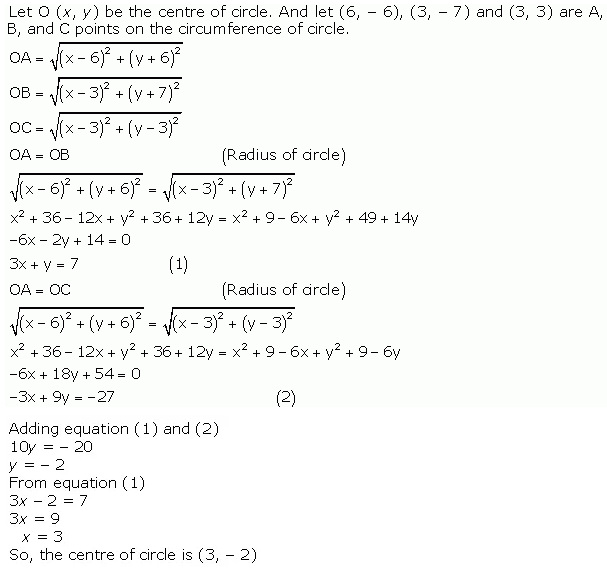
Question 4.
The two opposite vertices of a square are (-1, 2) and (3, 2). Find the coordinates of the other two vertices.
Solution:
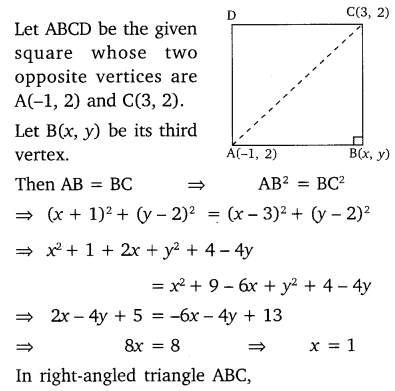
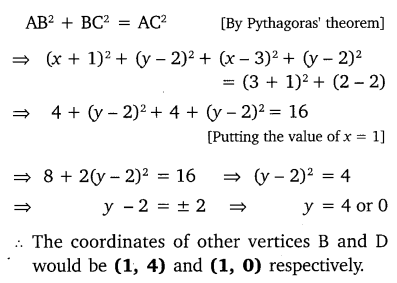
Question 5.
The class X students school in krishnagar have been allotted a rectangular plot of land for their gardening activity. Saplings of Gulmohar are planted on the boundary at a distance of 1 m from each other. There is triangular grassy lawn in the plot as shown in the figure. The students are to sow seeds of flowering plants on the remaining area of the plot.
(i) Taking A as origin, find the coordinates of the vertices of the triangle.
(ii) What will be the coordinates of the vertices of ∆PQR, if C is the origin?
Also, calculate the areas of the triangles in these cases. What do you observe?

Solution:
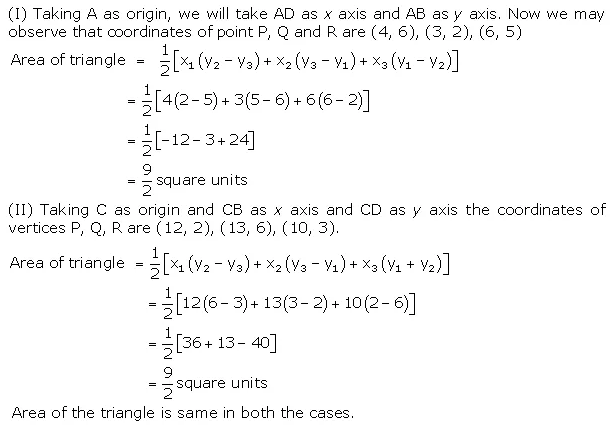
Question 6.
The vertices of a VABC are A(4, 6), B(1, 5) and C(7, 2). A line is drawn to intersect sides AB and AC at D and E respectively. such that 𝐴𝐷𝐴𝐵=𝐴𝐸𝐴𝐶=14. calculate the area of the ∆ADe and compare it with the area of ∆ABC.
Solution:
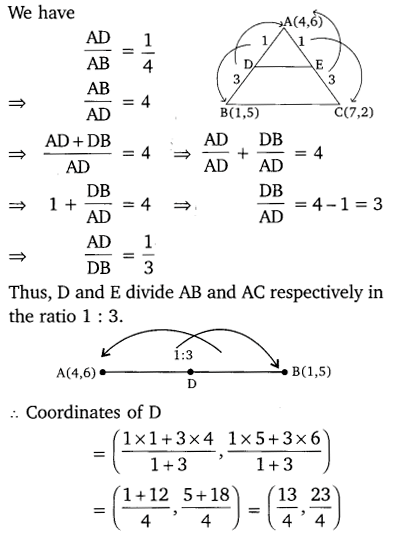
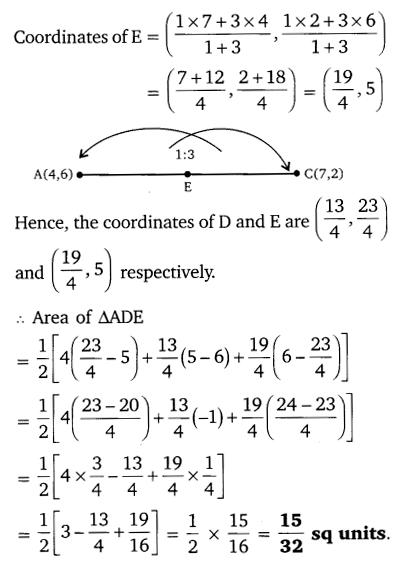
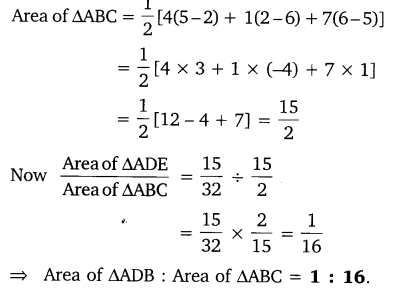
Question 7.
Let A(4, 2), B(6,5) and C(1, 4) be the vertices of ∆ABC.
(i) The median from A meters BC at D. Find the coordinates of the point D.
(ii) Find the coordinates of the point P on the AD, such that AP: PD = 2: 1.
(iii) Find the coordinates of points Q and R on medians BE and CF respectively, such that BQ: QE = 2: 1 and CR: RF = 2: 1.
(iv) What do you observe?
[Note: The points which are common to all the three medians is called centroid and this point divides each median in the ratio 2: 1]
(v) If A(x1, y1), B(x2, y2) and C(x3, y3) are the vertices of ∆ABC, find the coordinates of the centroid of the triangles.
Solution:
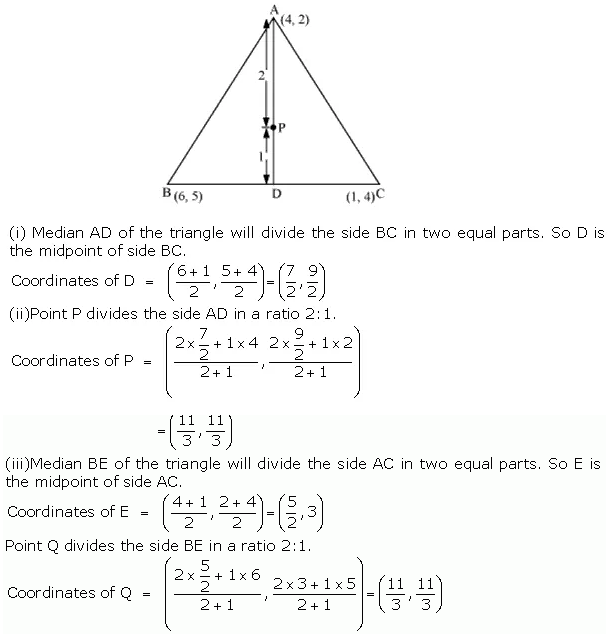
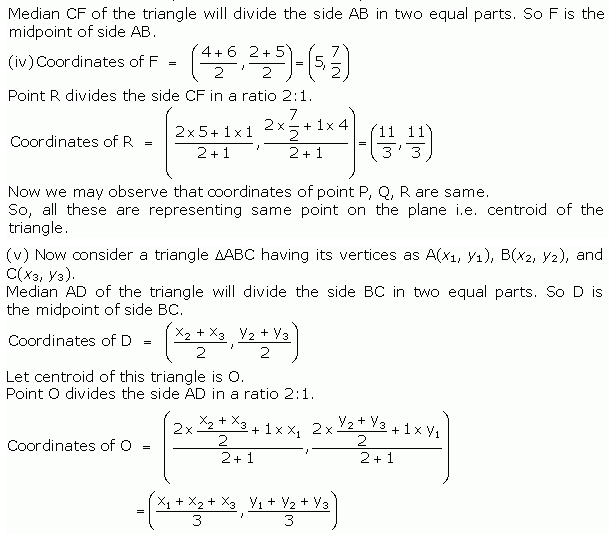

Question 8.
ABCD is a rectangle formed by the points A(-1, -1), B(-1, 4), C(5, 4) and D(5, -1), P, Q, R and S are the mid-points of Ab, BC, CD and DA respectively. Is the quadrilateral PQRS a square? a rectangle? or a rhombus? Justify your answer.
Solution:

P id the mid-point of side AB,
Coordinate of P = ( (-1 – 1)/2, (-1 + 4)/2 ) = (-1, 3/2)
Similarly, Q, R and S are (As Q is mid-point of BC, R is midpoint of CD and S is midpoint of AD)
Coordinate of Q = (2, 4)
Coordinate of R = (5, 3/2)
Coordinate of S = (2, -1)
Now,
Length of PQ = √[(-1 – 2)2 + (3/2 – 4)2] = √(61/4) = √61/2
Length of SP = √[(2 + 1)2 + (-1 – 3/2)2] = √(61/4) = √61/2
Length of QR = √[(2 – 5)2 + (4 – 3/2)2] = √(61/4) = √61/2
Length of RS = √[(5 – 2)2 + (3/2 + 1)2] = √(61/4) = √61/2
Length of PR (diagonal) = √[(-1 – 5)2 + (3/2 – 3/2)2] = 6
Length of QS (diagonal) = √[(2 – 2)2 + (4 + 1)2] = 5
The above values show that, PQ = SP = QR = RS = √61/2, i.e. all sides are equal.
But PR ≠ QS i.e. diagonals are not of equal measure.
Hence, the given figure is a rhombus.







